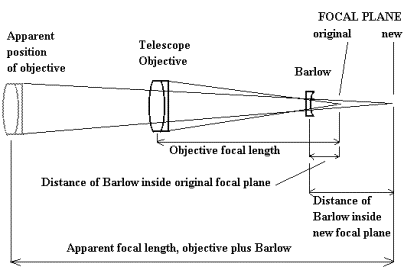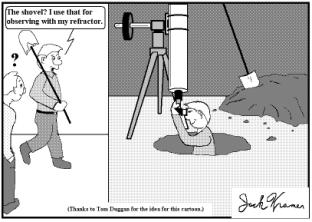Barlow vs Eyepiece
Jack Kramer
What's the best way to increase the magnification in a telescope - a short focal length eyepiece or a longer focal length eyepiece coupled with a Barlow lens? There are valid points on both sides.
The diagram below shows how a Barlow increases magnification. In simplest terms, it tricks the eyepiece into acting as though it's working with a longer focal length telescope. This "apparent focal length" is dictated by the stated magnification factor of the Barlow, usually 2x or 3x. If the focal length of your ocular is 16mm, when used with a 2x Barlow it would provide the magnification of an 8mm. One advantage of a Barlow is that it allows you to expand the range of your available magnifications without investing heavily in a lot of different eyepieces. And from the standpoint of ergonomics it's more comfortable to observe at higher power with a long focal length eyepiece that has greater eye relief and larger lenses.
 Barlows usually have some effect on the characteristics of the eyepiece with which they are used. For example, the eye relief of the eyepiece may be altered. And in rare instances, users reported that they are not able to reach focus using a Barlow with certain eyepieces (the Plossl design seems to be the most problematical). The effects vary with the quality and/or design of the Barlow and the eyepiece. Another effect is a change in the image quality, specifically in the sharpness of the image. Lesser quality Barlows may also cause vignetting, which is a falloff in brightness at the edge of the field of view. Unfortunately, inferior quality Barlows are commonly included with scopes sold in department stores in order to increase magnification to impossible levels.
Barlows usually have some effect on the characteristics of the eyepiece with which they are used. For example, the eye relief of the eyepiece may be altered. And in rare instances, users reported that they are not able to reach focus using a Barlow with certain eyepieces (the Plossl design seems to be the most problematical). The effects vary with the quality and/or design of the Barlow and the eyepiece. Another effect is a change in the image quality, specifically in the sharpness of the image. Lesser quality Barlows may also cause vignetting, which is a falloff in brightness at the edge of the field of view. Unfortunately, inferior quality Barlows are commonly included with scopes sold in department stores in order to increase magnification to impossible levels.
The first Barlow lens came into general use about fifty years ago and early versions were just as the name implies - a single plano-concave lens. Although these simple lenses worked, they had all the problems mentioned above, plus they induced varying amounts of chromatic aberration into the image. Eventually, the design was changed to incorporate an additional lens element to make them achromatic. Today we still refer to it as a Barlow lens, though all of them are now made with at least two lens elements, and some with as many as four. The best Barlows have greatly minimized any problems by using the highest quality lenses and optical coatings. Some boast three lens elements to make them "apochromatic". Are they better than the two-element achromatic Barlows? From what I've heard and experienced personally, any difference is not immediately obvious. But it so happens that two units that have consistently garnered favorable reviews from users - the Celestron Ultima and Orion Ultrascopic - are both of the three-element design. However, another consideration is that when you put more elements into the optical system with a Barlow, you're increasing the likelihood of adversely affecting both the light throughput and image sharpness to some degree.
For these reasons, picky observers often shun the use of Barlows, preferring straight eyepieces. Meanwhile other observers are unable to detect any deterioration in image quality caused by a Barlow. Of course, after you add a Barlow the image is affected very much as though you had switched to a shorter focal length eyepiece - it's no longer quite as crisp as it was and the actual field of view is smaller. On the plus side, you've retained the ergonomic advantage of the longer focal length ocular, including its apparent field of view.
Barlows come in .965", 11/4" and 2" formats, and there are two types of standard 11/4" format Barlow lenses - the full-length (long) type and those commonly referred to as "shorty" Barlows. Most full-length Barlows (such as the Orion Ultrascopic) can only be used in a Newtonian telescope because they extend deep into the focuser tube. In a refractor or SCT they could hit the mirror or prism in the star diagonal. Because of their shorter focal lengths, the short versions (e.g.: the Orion Shorty Plus) are more sensitive to the placement of the eyepiece, and will deliver a variety of magnifications with different eyepieces. A full-length version tends to give the stated magnification factor more consistently.
The magnification factor of a Barlow (2x, 3x, etc.) is determined by the design of the lens and its distance from the eyepiece. But it's more of an approximation. A few years ago, Sky & Telescope magazine tested a number of Barlows and found that few of them gave the exact stated magnification factor. Almost all were a little over or under, and a few were off by a fairly wide margin. I have a 2x Meade (#126) Shorty Barlow that actually gives 1.76x. The effective magnification factors can also vary depending on the design of the eyepiece with which the Barlows happen to be used.
The placement of the Barlow at various distances from the ocular can yield a considerable range of magnifications. If you have a refractor or SCT and place the Barlow in front of the star diagonal instead of in front of the eyepiece, you've increased the critical distance; thus instead of getting a rated magnification factor of let's say 2x, you'd actually get something around 3x. I've used a Barlow in both positions on one of my refractors and this really does expand its capability. Barlows are also used with binocular viewers to bring the focal point out far enough so you can reach focus. In this application, they're sometimes referred to as a "transfer lens". Because of the long optical train in a binocular viewer, the effective magnification factor of a Barlow will be much greater than its stated factor.
Another use for a Barlow is in negative projection astrophotography. In this configuration, you use a Barlow in the telescope, but without an eyepiece and without a lens in the camera. This magnifies the image beyond what you would get in prime focus mode, but not as much as with eyepiece projection photography.
The Tele Vue Powermate is another type of Barlow - its design is unique in that it causes no change to the characteristics of the eyepiece with which it's used. Except for increasing magnification, the Powermate is virtually transparent. But it does share one drawback common to all Barlows: since it uses a complex lens system consisting of four elements, it may very slightly reduce light throughput. But the effect is so slight that most users probably wouldn't notice. I find that my 2.5x Powermate gives sharp, bright images with a 12.5mm orthoscopic eyepiece, at an effective focal length of about 4.8mm. An orthoscopic ocular of 4.8mm focal length would have uncomfortably short eye relief and a peephole-sized eye lens.
Here are some suggestions when shopping for a Barlow:
� Do get one with as large a clear aperture as possible. The greater the clear aperture, the less chance there will be of vignetting due to the light being cut off by the edges of the Barlow lens cell. For example, the Klee Barlow sold by University Optics has one of the smallest clear apertures among standard Barlows, so its performance suffers in comparison to others.
� Look for a Barlow with lenses that are fully multi-coated; this will enhance light throughput and prevent scattered light. A Barlow that is simply "multi-coated" has coatings usually on the two outside lens surfaces. One that is listed as "fully multi-coated" has all the lenses coated on all air-to-glass surfaces. The Orion, Celestron Ultima, and Tele Vue models are fully multi-coated
� Make sure there is a setscrew to hold the eyepiece securely in the barrel of the Barlow.
� It's not generally a good idea to use a Barlow with a wide-field eyepiece of complex design (e.g.: Nagler, Radian, Pentax XW, etc.). Some of those eyepieces already incorporate a Barlow system as part of their design. Plus they contain from six to eight lens elements; add a Barlow, and you have a lot of glass to possibly compromise image quality.
� Don't spend more money than necessary. While the Powermate works great, I personally don't think it's worth over $100 more than a good standard Barlow such as the highly regarded Celestron Ultima.
Finally, consider whether you really need a Barlow. If your current eyepiece collection gives a pretty good range of magnifications, what will a Barlow do for you? I seldom use one because I have a wide range of eyepiece focal lengths and most are of a complex design. On the other hand, if you have one or two good eyepieces and several mediocre ones, you might want to use a Barlow as a less expensive way to expand the capabilities
Published in the January 2006 issue of the NightTimes





